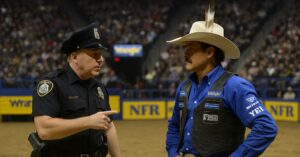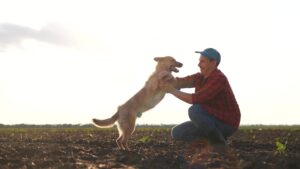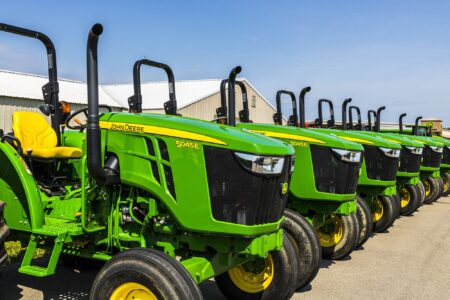The saying “necessity is the mother of invention” never rang truer than when describing the can-do attitude of farmers creating advances in machinery. The history of modern agriculture is rife with examples such as the finger-pickup and pneumatic planters, coulter chisel, combine, and corn picker. All those breakthroughs sprang from the minds of farmers seeking solutions to help with their fieldwork.
Pair necessity (the need for more horsepower to get fieldwork done) with the innate engineering ability farmers display, and wondrous machines emerge from farm shops, or in the case of the Steiger farm family, from a dairy barn.
During the 1950s in St. Hilaire, Minnesota, farmer John Steiger and sons Douglass and Maurice were looking for a tractor that would let them catch up with tilling in their growing operation and also allow them to bring in some extra income doing custom farmwork. The family considered buying a Wagner 4-wheel-drive tractor.
Mindful of their checkbook and dissatisfied with what they saw in the Wagner design, Doug and Maurice decided they could build their own machine for around $10,000.
Steiger Heritage Club
Created From Salvaged Parts
Their local bank recognized that the Steiger boys were gifted with engineering skills, and loaned them the money for the tractor. Douglass designed plans, Maurice took care of fabrication, and their father assisted with blacksmithing skills.
During the winter of 1957–58, the Steigers toiled in their dairy barn, creating their first tractor, a 24,000-pound machine mostly fashioned from used parts salvaged from mining equipment employed on Minnesota’s Iron Range. Power for their creation came from a Model 6-71 Detroit diesel paired with a Fuller 10-speed transmission and homemade transfer case.
What marked the Steiger’s 4-wheel-drive creation as unique was the tractor’s articulated “center bend.” The Steigers would later modify that design with a patented device they called the swinging power splitter, which allowed for a tighter turning radius than the Wagner machine.
The Steigers’ first manufacturing effort, the Steiger No. 1, rolled out of their barn in 1958 and immediately went to work tilling. Turning out a whopping 238 hp, the No. 1 stood at the top of the hill in power among all agricultural tractors at the time.
A couple of years later, the family built a second tractor, the Model 105, a lighter affair rated at 115 hp. Area farmers took notice of the Steiger fleet. A local dealer, Earl Christianson, said he would sell any tractors the Steiger brothers could build, and Steiger Tractor was created.
Improvements to the tractor continued, and led to the creation of the Models 2200 and 1700 in 1964. Douglass Steiger went on to design two additional models, the 1250 and 3300, as demand for their tractors grew from U.S. and Canadian farmers. Logging and industrial versions of the machines soon followed.
Steiger Heritage Club
The New Steiger Tractor Company Is Created
Enjoying a reputation of reliable, low-maintenance power, Steiger Tractor continued to expand during the 1960s, as did the Steiger farming operation. The family, realizing their limits when it came to running an expanding manufacturing operation, sold 52% of their interest in the business to a group of investors, who moved the firm to Fargo, N.D. That new firm, now known as the Steiger Tractor Company, renamed the current tractor models (which included the 1300 and 2250) the Tiger and Wildcat.
The Steiger boys continued to build tractors for the Steiger Tractor Company, as well as serve on the company’s board of directors. Eventually, all manufacturing moved to Fargo, where the company expanded the line to include the Bearcat and Cougar, while modifying the Tiger to the Turbo Tiger (thanks to the addition of a turbocharger).
Bobcat Skid-Steer Loader Creator Steps In
The addition of much-needed capital, which allowed the company to expand, came from Les Melroe (of Melroe Bobcat skid-steer loader fame), who had sold his business and used the funds from that sale to support Steiger Tractor. Gene Dahl and Jack Johnson brought additional investment to the company and also joined the Steiger leadership team.
The 1970s witnessed rapid expansion of the company, as Steigers readily sold across North America and then the world. In 1975, the firm, recognizing the need for additional manufacturing space, built a 420,000-square-foot plant (which is still in operation by Case IH) west of Fargo. That expansion came in handy, as Steiger was also producing 4-wheel-drives for other companies, including Allis-Chalmers, Ford CCIL (Canadian Co-op Implement Limited), and International Harvester.
Multiple State-of-the-Art Advances
The introduction of the Panther 1000 in 1982 marked several technological advances for Steiger tractors, including the use of a powershift transmission, electronic controls, pressure-compensated flow hydraulics, and an advanced cab. The next year, the Tiger KP Series IV model came out, offering 525 hp with an Allison 24-speed powershift transmission. And in 1986, Steiger introduced their first tractor offering articulated steering and a steerable front axle, the Model Puma 1000.
Despite all their advances and a solid reputation for building highly reliable, low-maintenance machines, Steiger’s sales suffered during the 1980s due to a depression in agriculture. At one time in the late 1980s, production in its factory sunk to 25% of its former capacity.
Forced into Chapter 11 bankruptcy protection, the company sold to Tenneco Inc. (which also owned Case IH) in 1986. Regardless of that bankruptcy, Case IH decided to retain the Steiger name, thanks to the tractor line’s solid reputation. Production continued at the Fargo manufacturing facility, and by 1997, the 40,000th Steiger was produced. Today, Case IH’s Steiger line of tractors includes seven models, offered in wheeled and Rowtrac or Quadtrac (tracks on both axles) versions.
An outstanding website, the Steiger Heritage Club, offers an extensive history of the company, as well as a vast array of images from the past.


:max_bytes(150000):strip_icc()/Markets-8-Soybeans-up-corn-down-10-39d51bc414e3404d8a298ad3f60968ec.jpeg)




:max_bytes(150000):strip_icc()/SteigerTigerTwoattheNebraskaTractorTestcopy-ddd29d4448df4315a3a45f7aa68a0512.jpg)

:max_bytes(150000):strip_icc()/AJF_3019-scaled-1ade05d0d79743dab72e18aa87c15a25.jpg)
:max_bytes(150000):strip_icc()/Markets-7-Corn-up-soybeans-down-3-8a19ee3772234e24930af71711d04827.jpeg)

:max_bytes(150000):strip_icc()/IMG_2890-1536x1152-3e525ec1627340a18d71eca413e6e1d6.jpg)